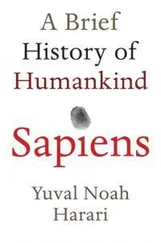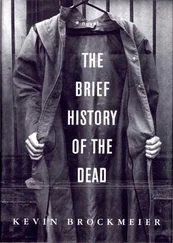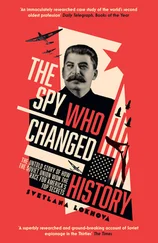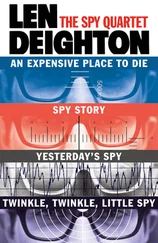Paul Simpson - A Brief History of the Spy
Здесь есть возможность читать онлайн «Paul Simpson - A Brief History of the Spy» весь текст электронной книги совершенно бесплатно (целиком полную версию без сокращений). В некоторых случаях можно слушать аудио, скачать через торрент в формате fb2 и присутствует краткое содержание. Город: London, Год выпуска: 2013, ISBN: 2013, Издательство: Constable & Robinson, Жанр: Прочая документальная литература, на английском языке. Описание произведения, (предисловие) а так же отзывы посетителей доступны на портале библиотеки ЛибКат.
- Название:A Brief History of the Spy
- Автор:
- Издательство:Constable & Robinson
- Жанр:
- Год:2013
- Город:London
- ISBN:9781780338910
- Рейтинг книги:3 / 5. Голосов: 1
-
Избранное:Добавить в избранное
- Отзывы:
-
Ваша оценка:
- 60
- 1
- 2
- 3
- 4
- 5
A Brief History of the Spy: краткое содержание, описание и аннотация
Предлагаем к чтению аннотацию, описание, краткое содержание или предисловие (зависит от того, что написал сам автор книги «A Brief History of the Spy»). Если вы не нашли необходимую информацию о книге — напишите в комментариях, мы постараемся отыскать её.
A Brief History of the Spy — читать онлайн бесплатно полную книгу (весь текст) целиком
Ниже представлен текст книги, разбитый по страницам. Система сохранения места последней прочитанной страницы, позволяет с удобством читать онлайн бесплатно книгу «A Brief History of the Spy», без необходимости каждый раз заново искать на чём Вы остановились. Поставьте закладку, и сможете в любой момент перейти на страницу, на которой закончили чтение.
Интервал:
Закладка:
Over the coming months the CIA would try to turn as many former East German operatives as they could — a procedure they would also try, with limited success, in the Soviet Union as that headed towards break-up. It wasn’t always successful: some former Communist officers felt that all they had left was their honour, and asked to be left alone. Others, like Markus Wolf himself, listened politely, but ultimately turned the Agency down. There were so many defectors in the end that the CIA eventually had to tell some to simply apply through normal channels for travel to the West.
However, the many new agents gained the CIA and other Western agencies access to materials they couldn’t have hoped for before, including the new SA-19 surface-to-air missile (SAM) that the Soviets had been developing. What they were not able to get — at that stage anyway — were the Stasi files, even though the East German security headquarters in East Berlin had been ransacked. Many of them had in fact been transferred to Moscow for safekeeping. Former enemies became allies, as the Czech agency, the StB, began cooperating with both the CIA and MI6.
There were those within the CIA who believed that the KGB was becoming toothless, as the power of the Communist state dwindled with the rise of independence movements in various Soviet republics during the start of 1991. Former head of operations in America Oleg Kalugin publicly criticized the KGB for its behaviour, noting that Gorbachev’s reforms would never amount to anything until the KGB’s power was reined in. The KGB tried to curb the independence movement in Lithuania around the time of the first Gulf War, when Saddam Hussein invaded Kuwait and was repelled, but this caused an outcry in Moscow and the CIA began hearing about a potential recall for some Army officers to preserve the Soviet Union. On 18 August 1991, two months after the election of Boris Yeltsin as Russian President, and as Gorbachev prepared to sign a New Union Treaty, which some believed would mean the end of the Soviet Union as they knew it, the KGB, led by Vladimir Kryuchkov, made its final move.
Mikhail Gorbachev was cut off from the outside world at his vacation home, as tanks began to line the streets of Moscow. Russians hurried to the parliament building, the White House, as Boris Yeltsin declared that a coup had taken place. Some of the military backed Yeltsin and a battle of wills ensued — with Yeltsin undoubtedly the eventual winner. The coup was defeated, and Gorbachev, who had been effectively side-lined during the crisis, resigned as Communist Party secretary, remaining as president until Christmas Day. In perhaps the most symbolic gesture, the statue of Felix Dzerzhinsky, the first leader of the Communist secret police, was torn down from in front of the KGB headquarters at the Lubyanka. The KGB limped on for a few more weeks under General Vadim Bakatin, but as the Soviet Union dissolved, so too did the KGB’s power. Its successors in the new Russia were the Foreign Intelligence Service (SVR), the Federal Security Service of the Russian Federation (FSB), and the Federal Protective Service (FSO).
At CIA headquarters, the Christmas party was promoted with a button that read ‘The Party’s Over’. And to an extent, it was — but the end of the Cold War would lead to major questions for all the world’s intelligence agencies, ones that would only really gain a full answer when two planes were piloted into the World Trade Center in New York City, and one into the side of the Pentagon, on September 11, 2001.
13
PRELUDE TO WAR
Although President Bush’s ‘War on Terror’ would not be officially declared until after the horrific events of 9/11, intelligence agencies had been involved in counter-terrorism operations for many years. The CIA and the FBI had been taking an interest in Osama bin Laden’s organization, al-Qaeda, since its formation in August 1988 during the tail end of the Soviet occupation of Afghanistan. The Israelis had exacted revenge on the Palestine Liberation Organisation (PLO) and other terrorist groups. The British continued to wage an undeclared war on the Irish Republican Army (IRA) and the many other cadres in Eire and Northern Ireland, as well as dealing with Middle Eastern terrorists. Eastern Bloc countries such as the German Democratic Republic had spied on their own citizens on the pretext of preventing ‘terror’ attacks by capitalist forces. In South Africa, the Bureau for State Security (often referred to as BOSS) and its successor the National Intelligence Service dealt with perceived threats to the status quo, and, like the Stasi, often turned its attentions perhaps too closely on its own people.
On its website, the new South African State Security Agency (SSA) explains its remit, defining terrorism as ‘deliberate and premeditated attempts to create terror through symbolic acts involving the use or threats of lethal force to create psychological effects that will influence a target group or individual and translate it into political or material results’. Counter-terrorism agents often encounter attempts at subversion, which the SSA calls ‘activities directed at undermining by covert unlawful acts or intended ultimately to lead to the destruction or the violent overthrow of the constitutionally established system of the government’. It’s really irrelevant whether the motives of the terrorists are religious (as with the fundamentalists of al-Qaeda), or political (such as the PLO), or a quasi-mixture of the two (the IRA, whose creed is partly based on getting the British out of Ireland, and partly involved with the schism between Protestants and Roman Catholics); the definitions equally apply.
Terrorism as it is generally referred to today saw a resurgence at the end of the sixties. In Ireland, the IRA had ended its previous campaign in 1962, citing public indifference. However trouble flared in Northern Ireland again in the summer of 1968. An MI5 report commissioned by Home Secretary James Callaghan, pointed out that ‘In basic terms the security problem in Northern Ireland is simple. It springs from the antagonism of two Communities with long memories and relatively short tempers.’ Although historically, the IRA had been the responsibility of the Special Branch of the Royal Ulster Constabulary (RUC) — and the Special Branch of the Metropolitan Police for offences committed on the mainland — MI5 began to take a more active role, particularly after the UK government sent troops into Ulster on 14 August 1969.
Intelligence matters regarding the province remained confused over the next few years, with the odd division of responsibilities occasionally leading to costly failures. The Provisional IRA attack on the Parachute Regiment headquarters in Aldershot, Surrey (33 miles south-west of London), on 22 February 1972 led directly to the establishment of an Irish Joint Section (IJS) by MI5 and MI6. Arms shipments to the IRA from other countries were monitored and prevented where possible. Despite this, the IJS were unable to provide information that would deal with the IRA’s worst attacks on the mainland in 1974, in which forty-four people died. However, they were instrumental in setting up a back channel between the IRA and the Northern Ireland Office: this led to the Christmas 1974 ceasefire which then continued into 1975. By the time the IRA ended the ceasefire with a further campaign in London’s West End later that year, the counter-terrorism element of the intelligence agencies was working much more efficiently, with the IRA’s chief of staff Joe Cahill later admitting that ‘In many ways the Brits’ strategy was working and the movement had been caught flat-flooted.’
Numerous agents were run within the IRA over the next twenty years by both MI5 and MI6, but their identities, and successful operations, remain classified: there are still those who would take action against them, despite the 1998 Good Friday Agreement that brought a degree of peace to the province. The British Army and the IJS were also able to turn various members of the IRA, although this inevitably meant that they were, to an extent, condoning murder, since senior IRA men, such as Freddie Scappaticci, code-named Stakeknife, had to maintain their cover. MI5 took responsibility for targeting Loyalist paramilitary groups, assisting in the arrest of various members of the Ulster Defence Association.
Читать дальшеИнтервал:
Закладка:
Похожие книги на «A Brief History of the Spy»
Представляем Вашему вниманию похожие книги на «A Brief History of the Spy» списком для выбора. Мы отобрали схожую по названию и смыслу литературу в надежде предоставить читателям больше вариантов отыскать новые, интересные, ещё непрочитанные произведения.
Обсуждение, отзывы о книге «A Brief History of the Spy» и просто собственные мнения читателей. Оставьте ваши комментарии, напишите, что Вы думаете о произведении, его смысле или главных героях. Укажите что конкретно понравилось, а что нет, и почему Вы так считаете.












